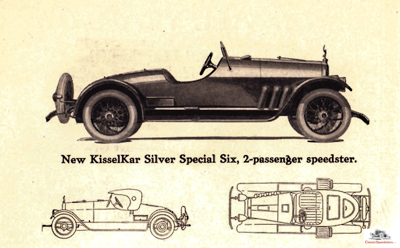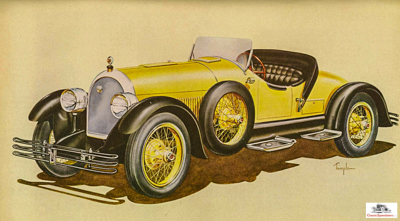Scores of automobile manufacturers of the early 20th century could claim that they included a speedster in their model lineup. However, very few could boast that they sold a speedster or speedster-like model for most of their years of production. Kissel, a storied brand that hailed from snowy Wisconsin, stood out as one company that dared, year after year, to offer a car built for fun and adventure despite the ups and downs of an uncertain capitalistic economy. Imagine that!
This is their story.
Kissel Motor Car Company Logo
Company Origin
The Kissel Motor Car Company was a family-owned manufacturing concern that once operated in Hartford, Wisconsin. William and George Kissel started the business in 1906 with the support of two other brothers and backing from their father, who owned a successful farm implements manufacturing business. The initial Kissels were assembled with components until sales success afforded them the opportunity to make their own parts and assemblies, which transformed their business model and would inform their work culture.
Kissels were built by hand to a very high standard of quality “in the German tradition,” aided by hiring gifted engineering talent imported from Germany. “Kissel Custom Built” was their advertising slogan and core belief. As touted in Kissel sales brochures, their cars were made
as if to individual order, under one roof, where
uniformly high standards of workmanship govern
every detail of design and construction.
This was the Kissel mandate: build or rework everything that went into their cars to meet their very own stiff requirements. And what they produced were magnificently hand-built beauties for an affluent middle class market.
First Gen: The Semi-Racers, 1909-1914
Kissel made a variety of models as did most auto companies, but one unique feature of the firm is that they produced a racy style of car during the majority of operations, from their beginning in 1906 until the factory doors were shuttered in 1930.
Illustration courtesy AACA Library
In 1909, Kissel rolled out the Kissel Kar G-9 Semi-Racer, an open-cockpit model that continued in some form until 1914. This speedster type of vehicle was all the rage in this era, as it emulated many track-oriented competitors that were grabbing headlines in newspapers all over the country. Contemporaries in this category such as the Stutz Bearcat, the Mercer Raceabout, and the Marmon 32 Speedster were all winning in hillclimbs, on the roads, and on the tracks. And winning in the showrooms, too!
1912 Kissel Model 4-30 Semi-Racer. Wisconsin Auto Museum
The second iteration of semi-racers, as seen in the offerings for 1913-14, mounted short doors for a runabout look. The stated purpose of the car was shifting away from pure adventure and more geared toward a practicality of sorts. As worded in their brochure for 1913:This model has found special favor with owners who
have bigger cars mostly devoted to family use, and who
wish a smaller lively car for business service.
Although Kissel chose not to sponsor a race team, their sales probably benefited from having a semi-racer or speedster in the showroom. After all, this was a time in automotive history when driving a speedster was synonymous with fun and adventure! Sporty models such as this often brought onlookers in, which many times resulted in a purchase of a more sedate but practical model. Sales grew from about 100 units sold in 1907 to over 750 in 1912, during which time Kissel employed a workforce of over 1000. (ILLUS Kissel factory at night)
Kissel Factory Hartford, WI circa 1912, plus 2nd factory in Milwaukee!
Second-Gen: The Custom-Builts, 1918-1927
1918 Kissel Silver Special Speedster. Note the external exhaust pipes and the no-door configuration for this prototype. AACA Library
Kissel also emulated the design trend of the late nineteen-teens and soon offered a sports-bodied model that was officially called a Speedster. Appearing at the New York Auto Show in January 1918, The Kissel Kar Silver Special Speedster was named (in part) to acknowledge the design influence of its most enterprising dealer, Conover Silver, and the model proved to be an instant hit at this salon.
In 1919, after some judicious name changes, the phrase “custom-built” was inserted to place an emphasis on the quality of Kissel automobiles. As stated in a full-page ad that appeared in the June 14 issue of The Literary Digest,
It all came about by out metropolitan distributors
suggesting that we meet the growing demand for a
custom-built motor car of those aristocratic motorists
who find it necessary to won an automobile with the
individual appeal of the made-to-order job – a car that
would match their standards and meet their ideals of
the ultra in appearance – a motor car that would prove
equal to a “bit of sport” without taking the other fellow’s dust.
So there you have it: Kissel stood for hand-crafted, powerful, sporty, and fast. And the Kissel Speedster was touted as “fleetness and power combined with rakishness and style.”
Later in 1919, Kissel loaned a Special Speedster to a newspaper reporter from The Milwaukee Journal and sent him on a tour of Wisconsin as part of a two-month campaign for better roads (this was the time of the Good Roads Movement). During this promotional event the Speedster, sporting a bright yellow body, inspired onlookers to give it the nickname “Gold Bug.” And although it was never an official company designation, this moniker has stuck with the Kissel Speedster since that time!
1923 Kissel Model 55 Speedster. Illustration courtesy AACA Library
Several iterations of the Speedster ensued, and refinements were made to improve on the basic idea from 1918, including adding a door, then two, replacing the slide-out running board seats with a rumble seat for a 2/4 seating option, fitting a fixed hard top, and stretching the chassis. Upgrades of and changes to its engines, both 6-cylinder and 8-cylinder, also occurred, making the 1926 and 1927 versions a much more refined model than their antecedent from 1918. Continuous improvement was a hallmark of Kissel and part of its work culture as reported in their company periodical, The Kisselgraph.
Third-Gen: White Eagles, 1928-1931
The White Eagle Speedster, as seen in the ad above, was introduced in 1928 and represented both a final refinement of the original concept and an attempt to revive the company’s sales. This nomenclature was applied to all models of Kissel, but the White Eagle Speedsters of 1928-1931 were a crowning achievement for the company, a model that also served as a harbinger of the luxo speedsters that would soon be offered by the likes of Packard, Auburn, and Duesenberg. The white-painted bodies were fitted onto 132- and 136-inch chassis and motivated by a powerful inline-eight of 115 horsepower. With everything rubber-mounted, White Eagles were almost vibration-free. These were chariots of the gods.
1929 Kissel White Eagle Speedster. Illustration courtesy Wisconsin Automotive Museum
The roiling economy of the 1920s, however, was not kind to independent automobile manufacturers like the Kissel Motor Car Company. Both the stock market crash of 1929 and the ensuing economic collapse killed markets and dealt a final death blow to the firm, which closed in 1931.
More about the Kissel range of speedsters can be found in the chapter on Kissels in my upcoming book on the classic speedsters movement. Stay tuned here for more news on that as the book progresses towards final editing and publication.
For an up-close and in-depth view of Kissels, schedule a visit to the Wisconsin Automotive Museum. You can find more information about this facility in Hartford, Wisconsin at
https://wisconsinautomuseum.com
Smoking stacks in these times meant production! Postcard image courtesy Wisconsin Automotive Museum
Next post:
Let’s look at a special luxo speedster!











